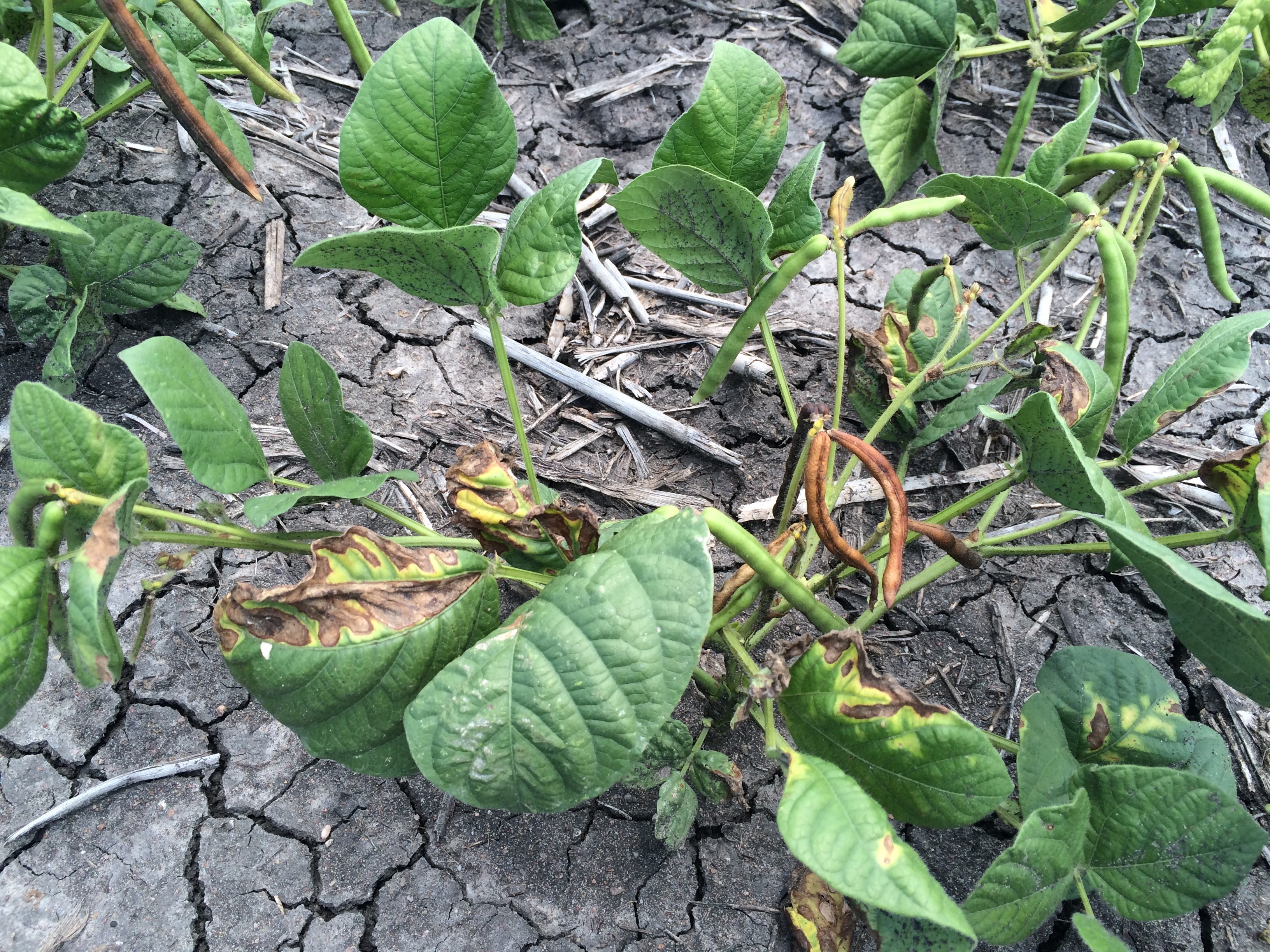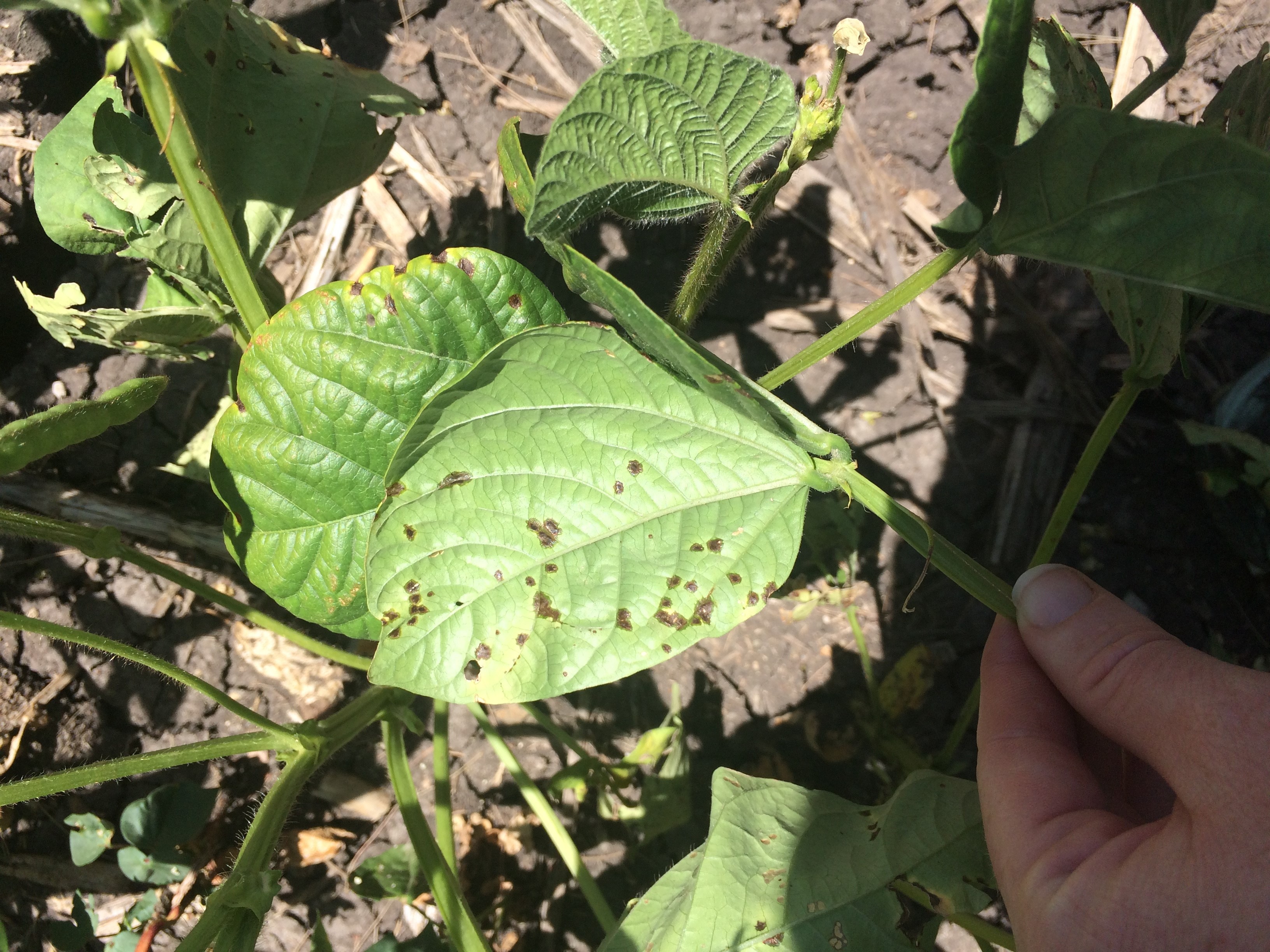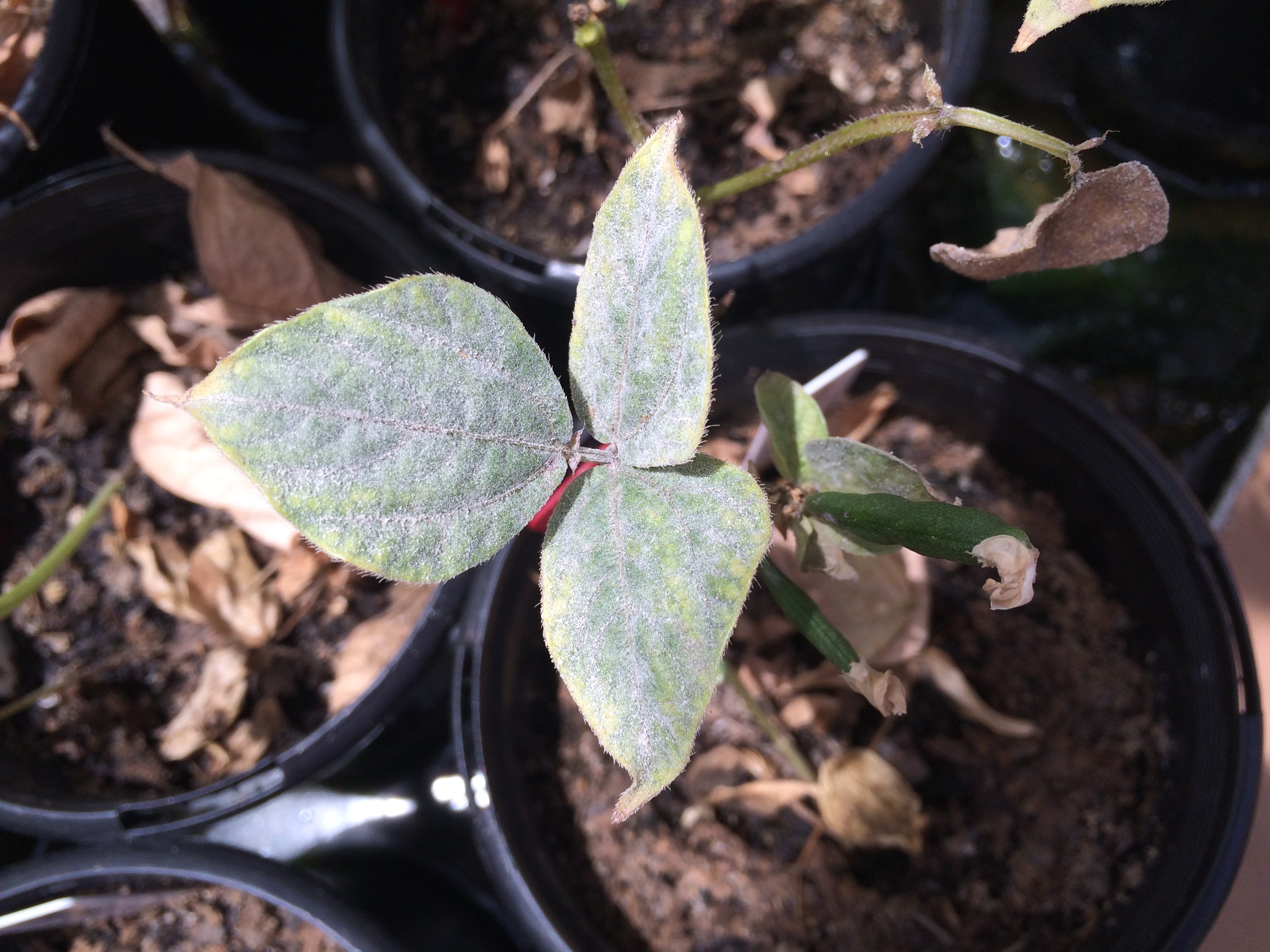Integrated disease management strategies in mungbean
Author: Lisa Kelly, Department of Agriculture and Fisheries | Date: 14 Aug 2019
Take home messages
- Effective disease management relies on adopting several strategies
- To minimise the risk of halo blight and tan spot plant seed with the lowest possible levels of infection, use varieties with higher levels of resistance, ensure good farm hygiene, control weeds and volunteers, and adhere to recommended crop rotations
- The impact of powdery mildew is minimised by planting varieties with higher levels of resistance, and by applying fungicides at the first sign of disease.
Introduction
Mungbean has become a valuable summer crop grown across Queensland and northern New South Wales (NSW). Diseases continue to be a constraint to many mungbean growers across the northern region in all seasons. The major diseases affecting mungbean in NSW and Queensland are the seed-borne bacterial diseases tan spot and halo blight, and the fungal disease powdery mildew. Emergent and less-well understood diseases are Fusarium wilt and root rot, charcoal rot, root knot and root lesion nematodes, phytoplasma, and other disorders such as gummy pod and puffy pod. Not all diseases are found in crops each year. The incidence and severity of diseases will depend on the interaction between the pathogen, the host, the environment, and vectors in the case of viruses and phytoplasmas. Halo blight, tan spot and powdery mildew are the most common diseases of mungbean and are typically present each season.
Tan spot
Tan spot (also known as bacterial scorch or bacterial wilt) is caused by the bacterium, Curtobacterium flaccumfaciens pv. flaccumfaciens (Cff). Plants can be affected at all stages of growth. Seed borne infection will result in seedlings with symptoms seen on the 1st or 2nd trifoliate leaf where large chlorotic areas develop. Affected seedlings often wilt and die, or those that survive will be stunted and remain a source of inoculum for later infection in the crop. Leaves on older plants develop a scorched appearance, with interveinal necrotic lesions surrounded by a distinct chlorotic margin (see Figure 1). Lesions become tan in colour and become papery in nature, these may disintegrate during windy weather. The bacteria can cause death of florets, and small pods may abort or remain stunted. The bacterium is thought to be systemic within plants and will infect seeds. Bacterial cells enter plants through the vascular system from infected seeds, or through wounds on aboveground plant parts, for example as a result of wind, rain and hailstorms. The bacteria that causes tan spot can survive on plants without producing symptoms. Disease development is favoured by high temperatures (>30°C) and plant stress.
 Figure 1. Symptoms of tan spot on mungbean with large tan-coloured interveinal necrotic lesions on leaves. Note that younger lesions are surrounded by a distinct yellow margin whereas the margin is less noticeable in older lesions.
Figure 1. Symptoms of tan spot on mungbean with large tan-coloured interveinal necrotic lesions on leaves. Note that younger lesions are surrounded by a distinct yellow margin whereas the margin is less noticeable in older lesions.
Halo blight
Halo blight is caused by the bacterium Pseudomonas savastanoi pv. phaseolicola (Psp). Similar to tan spot, the pathogen that causes halo blight can infect mungbean plants at any stage of growth. Infected seedlings are often a result of seed borne infection. Symptoms are often visible at the 1st or 2nd trifoliate leaf stage, characterised by small, water-soaked lesions that are surrounded by a yellow-green halo. Infected seedlings typically survive and act as a source of inoculum for later infection in the crop. Older lesions have less pronounced haloes and merge to produce larger necrotic regions (see Figure 2). Lesions are visible on both sides of leaves. Circular water-soaked lesions may develop on pods, with bacteria oozing from the lesions and often forming a red or brown crusty drop. Seed directly below pod lesions are often infected internally. Seed can become infected externally as it touches bacteria from infected crop debris or other infected seed.
The bacteria that causes halo blight is spread to healthy plants by water droplets from rainfall or overhead irrigation and contact between adjacent wet leaves. The bacterium enters plants through wounds and natural plant openings during periods of high humidity. Similar to tan spot, the halo blight bacterium can survive on the surface of both resistant and susceptible plants, without producing any obvious symptoms of disease. Disease development is favoured by cooler temperatures (18-23°C) and wet weather.

Figure 2. Plants infected with the halo blight pathogen have small, water-soaked lesions on both sides of leaves.
Powdery mildew
Powdery mildew of mungbean is caused by the fungus Podosphaera xanthii. The fungus has had multiple name changes in recent years and its taxonomy remains unclear. To complicate matters further, a different powdery mildew species was found on mungbean in 2018 and again in 2019, suggesting that at least two species of powdery mildew are infecting mungbeans across the northern region. Research is underway to identify this second powdery mildew and gain a greater understanding of the disease it causes.
Recent trials have demonstrated that P. xanthii can reduce yields by more than 40% in conducive seasons, when established well before flowering. Plants can be infected at any stage of growth, when air-borne spores land on the plant surface and germinate. The fungus then sends feeding structures (haustoria) into the cells of the leaf (epidermis), and then chains of spores develop from fungal strands, resulting in the white, powdery growth on infected tissues. Symptoms are first evident on the lower leaves as small, circular, white powdery colonies that can quickly move up plants and cover the surface of leaves under ideal conditions (see Figure 3). If severe enough, powdery mildew will also cover the stems and pods of plants. The fungus will only survive on living hosts and will not survive between seasons on seed or in crop debris. Plants are only infected via air-borne spores from nearby infected plants. It is not currently known what other weed and crops host P. xanthii, though it is thought to have a wide host range. Disease development by P. xanthii is favoured by cool (22-26ºC), dry weather and often is first seen in mungbean crops from autumn onwards across the northern region. Recent trials indicate that agronomic practices, such as row spacing, has minimal impact on disease severity.
 Figure 3. White fungal growth on leaves caused by the mungbean powdery mildew pathogen.
Figure 3. White fungal growth on leaves caused by the mungbean powdery mildew pathogen.
Integrated disease management strategies
Utilising an integrated disease management strategy is the most effective way to minimise the risk of disease epidemics. Relying on one strategy alone will not be enough to prevent disease. The three aims of integrated disease management are to reduce pathogen inoculum carrying over from one season or paddock to the next, exclusion of the pathogen, and protection of the host.
Reduction of inoculum
Paddock selection and crop rotation
Selection of the most suitable paddock requires consideration of previous crops, the history of diseases in the paddock, the presence of other crops and weeds nearby, and the herbicide history. The presence of herbicide residues in the soil may also cause crop damage and favour the development of some diseases. Many pathogens have a wide host range and can infect neighbouring crops and survive in crop debris. Table 1 displays the range of hosts reported for either both or one of the halo blight and tan spot pathogens. Avoid planting two consecutive legumes in the same paddock, and rotate mungbeans with other crops for at least three years to help break the pathogen cycle. Soil borne pathogens, such as Fusarium wilt, will survive in the soil for several years. Paddocks with a history of soil borne diseases, such as Fusarium wilt, should be avoided.
Control volunteers and weed hosts
Many pathogens will survive between seasons on volunteer mungbeans and weed hosts (see Table 1 for the hosts of the bacterial diseases), and they should be managed through herbicides or other practices.
Table 1. Host range of the halo blight and/or tan spot pathogens
Scientific name | Common name | Host of halo blight (HB) or tan spot (TS) |
|---|---|---|
Cajanus cajan | Pigeon pea | HB |
Desmodium spp. | Tick clover | HB |
Dolichos spp. | Dolichos lablab | TS,HB |
Fumaria sp. | Fumitory | HB |
Glycine max | Soybean | TS |
Ipomoea diamantinensis | Cowvine | TS |
Ipomoea plebeia | Bellvine | TS |
Lablab purpureus | Hyacinth bean | TS,HB |
Lupinus polyphyllus | Garden lupin | TS |
Macroptilium atropurpureum | Siratro | HB |
Macroptilium lathyroides | Phasey bean | TS |
Mercuialis annua | Annual mercury | HB |
Neonotonia wightii | Perennial soybean | HB |
Phaseolus spp. | various beans | TS,HB |
Pisum sativum | Pea | TS,HB |
Pueraria sp. | Kudzu vine | HB |
Sonchus oleraceus | Sowthistle | HB |
Vigna spp. | various beans | TS,HB |
Stubble management
Many pathogens will survive between cropping seasons in crops debris and in infected stubble. There may be a role for the removal of crop debris and stubble management when there is a high risk of inoculum carrying over to the next crop.
Exclusion of the pathogen
Low risk planting seed
Both halo blight and tan spot are highly seed-borne. Growers should avoid sowing seed from a crop that has shown symptoms of either halo blight or tan spot. Australian Mungbean Association approved seed is sourced from crops that were inspected for symptoms of halo blight and tan spot during the growing season. The development of a reliable test to screen seed for the presence of the bacteria is underway.
Practice good hygiene
Many pathogens of mungbean are spread through the movement of soil (e.g. the pathogens that cause Fusarium wilt, charcoal rot, and root lesion nematodes), or infected crop residues (e.g. the bacteria that cause halo blight and tan spot). Movement through the crop should be avoided to minimise wounding the foliage and spreading the pathogens further, particularly when the crop is wet. Any machinery, vehicles, other equipment, and boots should be thoroughly cleaned prior to entering a crop. Where possible, overland water flow should be managed to minimise the potential risk from contaminated soil and crop debris. Overhead irrigation should be avoided to minimise the risk of spreading disease further.
Protection of the host
Planting resistant varieties
Celera II-AU has the best levels of resistance to the halo blight pathogen, although this variety is suited to a niche market. Jade-AU and Crystal offer the best resistance to the tan spot bacterium, although heavy infection and yield loss can still occur under high disease pressure. Jade-AU offers the best resistance to the powdery mildew pathogen, although significant yield losses can still occur without the strategic use of fungicides.
Fungicides
Currently, there are no permitted or registered chemical treatments for the control of bacterial and fungal pathogens on mungbean seed. There are also no effective chemical treatments for the control of the bacterial diseases, tan spot and halo blight, once they have established within a crop. Tebuconazole, and Custodia® (120 g/L azoxystrobin and 200 g/L tebuconazole) are currently available for use under APVMA minor use permit for the control of powdery mildew in mungbean (PER13979 (expires 30-June-2020) and PER82104 (expires 30-Nov-2022), respectively). Fungicides should be applied at the first sign of powdery mildew and then again 14 days later, if needed.
Crop monitoring and diagnostics
Crops should be closely monitored for the early detection of diseases. Early detection of diseases can help to avoid spreading the disease further throughout a crop. This is particularly important for powdery mildew where fungicides should be applied at the first sign of disease.
Samples can be sent to the Department of Agriculture and Fisheries for disease diagnosis. Plant samples should be wrapped in paper towel and placed in labelled zip-locked bags and sent via courier or express post to Lisa Kelly, DAF, 203 Tor St, Toowoomba Qld 4350.
References
CABI/EPPO (2010) Curtobacterium flaccumfaciens pv. Flaccumfaciens. Distribution Maps of Plant Diseases, No. 370, CABI Head Office, Wallingford, UK.
EPPO (2011). Curtobacterium flaccumfaciens pv. flaccumfaciens. Bulletin OEPP?/EPPO, 41, 320-328.
Matingoni AC, de Cassia Camara R (2006). Curtobacterium flaccumfaciens pv. Flaccumfaciens detection in bean seeds using semi-selective culture medium. Brazilian Journal of Microbiology. 37, 451-455.
Noble T, Young A, Douglas C, Williams B, Mundree S (2019). Diagnosis and management of halo blight in Australian mungbeans: a review. Crop and Pasture Science, 70, 195-203.
Young JM (2010). Taxonomy of Pseudomonas syringae. Journal of Plant Pathology, 92, S1.5-S1.14
Acknowledgements
The research undertaken as part of this project is made possible by the significant contributions of growers through both trial cooperation and the support of the GRDC, the author would like to thank them for their continued support. Thanks to Col Douglas for his comments and reviewing this paper.
Contact details
Lisa Kelly
Plant Pathologist
Department of Agriculture and Fisheries
203 Tor St, Toowoomba Qld 4350
Mb: 0477 747 040
Email: lisa.kelly@daf.qld.gov.au
® Registered Trademark
Varieties displaying this symbol beside them are protected under the Plant Breeders Rights Act 1994
GRDC Project Code: DAQ00186,
Was this page helpful?
YOUR FEEDBACK
